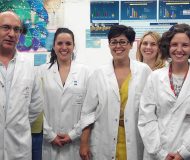

Researchers at CIBER Cardiovascular Diseases (CIBERCV) have made progress in identifying the mechanisms involved in the generation of oxidative stress, a fundamental process in vascular remodelling that takes place during the development of different vascular pathologies such as atherosclerosis, restenosis, hypertension or abdominal aortic aneurysm.
In a study published in the Journal of Molecular and Cellular Cardiology, carried out by the CIBERCV groups of José Martínez González, CSIC researcher at the Institut de Recerca de l’Hospital de la Santa Creu i Sant Pau and Mercedes Salaices at the Universidad Autónoma de Madrid, the mechanisms through which the nuclear NOR-1 receptor regulates the proliferation and migration of vascular cells are studied and a further step is taken in the identification of the target genes through which NOR-1 controls these processes.
“The identification of the mechanisms involved in the generation of oxidative stress could facilitate the development of useful drugs for the treatment of these diseases,” says CIBERCV group leader José Martínez González, who explains that “oxidative stress affects multiple aspects of arterial function and among others regulates the proliferation and migration of vascular cells.
In this work it is evident that in smooth muscle cells of the vascular wall (CMLV), NOR-1 increases the migration of these cells through the induction of oxidative stress. The researchers used overexpression techniques in human vascular cells to demonstrate that NOR-1 increases the expression of NOX-1, the main enzyme responsible for the production of oxidative stress.
Using molecular and cellular biology techniques, the authors determined that NOX-1 is a gene directly regulated by NOR-1. “In addition, we analyzed active human atherosclerotic lesions and observed that both NOX-1 and NOR-1 are expressed in the CMLV of the vascular wall, thus demonstrating their physiopathological importance,” explains the first signatory of the study, Judith Alonso.
The nuclear receptor NOR-1 modulates redox homeòstasi in human vascular smooth muscle cells.
Judith Alonso, Laia Canes, Ana García-Rodó, Pablo García de Frutos, Cristina Rodríguez, José Martínez-González